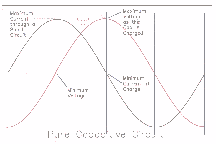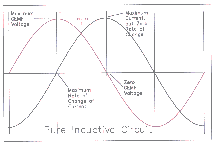Special Effects for Capacitors and Inductors with Variable Constant Current Sources
11/04/2001
A very important thought throughout this series of
"Special Effects" is the
"Opposition to the Rate of Change
for an Inductor",
and the "Rate of Charge for
a Capacitor".
Special Notes:
- "Constant Current Sources" are often misunderstood. We need to remember that a "Constant Current Source" is by definition a source that will maintain a set value of current, with whatever range of voltage is required to do so under various load changes.
- A "Constant Current Source" can be adjusted to new values of current, in gradient changes, step changes, or even sine wave changes, and still be referred to as "Constant Current Source" to the fixed or variable load conditions.
- By varying the settings of this "Constant Current Source" as it is applied to Reactive Loads, we can discover some very interesting and revealing phenomenon about Capacitive Reactance and Inductive Reactance.
The Reactance of a Capacitor to a "Rate of Changing Voltage of a Sine Wave"
 ICE
pdf file (44Kb) available.
ICE
pdf file (44Kb) available.
Note that the Current and Voltage relationships are 90° out of phase with each other, where at maximum voltage change (while crossing zero volts), that the charging current is maximum. Remember that Capacitors do not like voltage changes.
Note that in the illustration given, that where the current (I) is shown leading the voltage (E), and we can easily place the letter "C" between them ... hence the description "ICE" of the "ELI the ICE man". We can also say that the voltage is lagging the current.
The Reactance of an Inductor to a "Rate of Changing Current of a Sine Wave"
 ELI
pdf file (37Kb) available
ELI
pdf file (37Kb) available
Note that the Current and Voltage relationships are 90°
out of each other, where at the maximum current change (while
crossing zero), that the resulting CEMF is at its maximum.
Remember that Inductors do not like current changes.
Note that in the illustration given, that where the voltage (E) is shown leading the current (I), and we can easily place the letter "L" between them ... hence the description "ELI" of the "ELI the ICE man". We can also say that the current is lagging the voltage.
Particularly notice the difference between the "Reaction" of a Capacitor to the same variation of a "Constant Current Source" output, v.s. the "Reaction" of an Inductor to that same variation of current:
- When the source maintains a fixed value of current to the capacitor, the voltage across the capacitor increases in a "Linear" fashion, whereas that same fixed value of current through an inductor produces "no change" (remember that an inductor responds to changes in current).
- When the source current increases or decreases linearly through an inductor, the inductor produces a fixed "Step CEMF" voltage.
- A "Sine-Wave" variation of current from a "Constant Current Source" applied to a capacitor will result in a charging voltage across the capacitor to fall behind the current variation by 90°!
- A "Sine-Wave" variation of current from a "Constant Current Source" applied to an inductor will result in a CEMF that will lead the current variation by 90°!
- This totally different illustration of the relationship of those 90° phase angles is often referred to as "ELI v.s. ICE", to relate that in an inductive circuit the voltage always leads the current, and in a capacitive circuit, the voltage always lags the current.
Square Wave
Of special interest is that presenting a varying "Constant
Current Source" in the form of a
Square Wave
to a capacitor will produce a
Triangular Wave
output from the capacitor, (25Kb
PDF File)
whereas presenting a varying "Constant Current Source"
in the form of a
Triangular Wave
to an inductor will produce a
CEMF Square Wave
output from the inductor. (28Kb
PDF File)
This factor is one more situation of where a capacitor behaves
in the exact opposite of an inductor.
(Compare
those illustrations with this combined PDF File, 71Kb)
Special Considerations
For some REALLY SPECIAL considerations, look at what happens when we feed these irregular variations from a "Current Source" into an Inductor or a Capacitor ("Special" 66Kb PDF file):
- Contrasts between an Inductor and a Capacitor, when the current
is unchanging:
- The CEMF across the Inductor drops to zero.
- The voltage across the Capacitor will continue to change, by either increasing or decreasing.
- Contrasts between an Inductor and a Capacitor, when the supply
current increases:
- The CEMF across the Inductor will increase proportionally in opposition to the increase in current.
- The voltage across the Capacitor will increase at a higher proportionate rate.
- Contrasts between an Inductor and a Capacitor, when the supply
current decreases:
- The CEMF across the Inductor will reverse polarity to aid the current flow, in opposition to the decrease in current.
- The voltage across the Capacitor will still increase, but by a proportionate lesser rate.
- Contrasts between an Inductor and a Capacitor, when the supply
current is reversed, but unchanging:
- The CEMF across the Inductor simply drops to zero.
- The voltage across the Capacitor will decrease, but when
it reaches 0V, it will begin charging in the opposite polarity.
Takeaways
- Remember that an Inductor reacts to Changes in Current, but does not react if the current stays the same.
- A Capacitor will Keep Changing the Voltage across it when fed with a charging or discharging current, but will maintain the current voltage when the current supply is zero.
- Note especially that the "Roles" of an Inductor vs. a Capacitor seem to be the opposite of each other, in their "Reactions" to Current Sources.